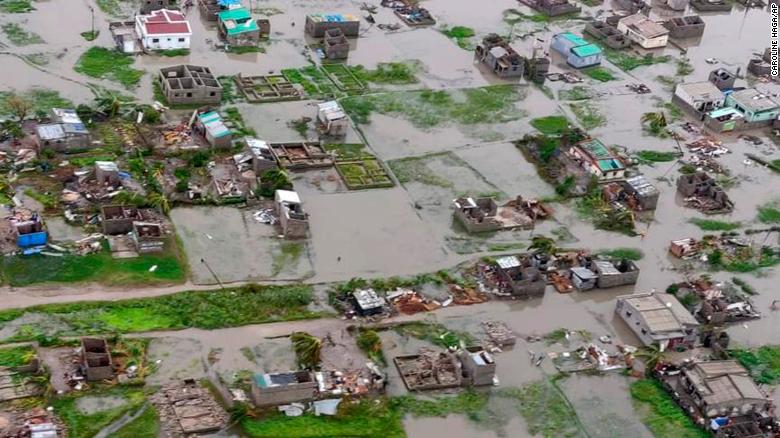Another Massive Disaster For Africa

"This is a major humanitarian emergency that is getting bigger by the hour."People desperately trying to outrace the floods report seeing hundreds of corpses washing up beside roads they travel on, while on the floodwaters rushing to the sea, corpses bob on the flash currents. "People were on the rooftops and in the eucalyptus, mango and cashew nut trees" described stranded motorist Graham Taylor, a Zimbabwean living in Mozambique who walked along a raised road the 25 kilometres it took to reach safety in Nhamatanda village. He counted passing 400 bodies on his trip, as survivors and relatives of the dead stood beside corpses, weeping.
"[Mozambique's Pungue and Buzi rivers overflowed creating] inland oceans extending for miles and miles in all directions [and where dams at 95 percent to 100 percent capacity resulted leading to overflow]."
"People visible from the air may be the lucky ones and the top priority now is to rescue as many as possible."
"[Many people were] crammed on rooftops and elevated patches of land outside the port city of Beira [and WFP was rushing to rescue as many as possible]."
Herve Verhoosel, World Food Program
"It's dire. We did an aerial surveillance yesterday and saw people on rooftops and in tree branches."
"The waters are still rising and we are desperately trying to save as many [people] as possible."
Caroline Haga, Red Cross, Beira, Mozambique
Aid workers rushed to rescue victims whose grasp on trees and balance on rooftops gambled against the rising waters reaching them in the wake of the cyclone Idai. "This is the worst humanitarian crisis in Mozambique's recent history" Jamie LeSueur, head of response efforts in Beira for the International Federation of Red Cross and Red Crescent Societies said, in describing a catastrophic natural disaster that has left 400,000 people homeless. "An inland ocean" was created in Mozambique by the rising floodwaters.
Tens of thousands of families are threatened as the scramble to rescue survivors and airdrop food, water and blankets is carried out by aid workers. In the midst of all of this, heavy rains adding to the flooding. Many roads are impassable, so the extent of the carnage remains guesswork since key roads have been washed away leaving aid groups unable to see food, medicine and fuel reach hard hit Beira, a city of 500,000 people, by air and sea.
:no_upscale()/cdn.vox-cdn.com/uploads/chorus_asset/file/15980420/GettyImages_1131946087.jpg) |
In Zimbabwe, the death toll rose to 98, according to the government where the mountain town of Chimanimani was struck, roads into the town cut off, leaving sole access by helicopter, and the death toll expected to rise steeply. A South African pilot at Beira airport said he had spotted up to 250 people sheltering on a small hill surrounded by floodwater on the south of the city. A rescue mission was delayed when a local government official ordered a plane to take him to the scene instead of directly coordinating a rescue mission. And then it was too late; the hill was inundated, everyone stranded on it lost.
The plains of Mozambique had 60 centimetres of water dropped by the cyclone, causing rivers to burst their banks and there was little warning when the first torrents came flooding and roaring through the villages. Desperate people hoping to find salvation grasped that the trees might provide safety. And three days later branches giving haven to one person now carry many people seeing them as refuge, but they are places from which there is no escape other than death. Now other creatures seeking haven have joined the people.
Among them snakes, while crocodiles swim in the waters below. And the people holding on to those branches in the trees have had no food, no drink, no rest and they have now no energy to continue their vigil. Exhaustion, and lack of sleep is now the stalking danger when falling asleep will result in falling in to the rapids, and few among the villagers can swim. Rescuers speak of having to make choices; there are so many awaiting help they must take the most vulnerable to safety, choosing children, leaving those who seem hale and those who are too old to continue fending for themselves.
And villagers living nearby who have small fishing boats of their own, dispatch themselves in their boats to attempt to rescue as many as they can, returning them to safety from their threatened positions above the floodwaters. One man tied strings of large plastic floaters behind his boat to increase his chances of rescuing those who could hold on behind his boat as he paddled to the safety of a firm, dry shoreline beyond the rushing torrents.
Africa's poorest countries are ill served by their geography, by the climate and by natural phenomena that even wealthy nations with modern technology and armies well equipped to mount rescue missions would be hard put to carry off.
/cdn.vox-cdn.com/uploads/chorus_image/image/63284095/GettyImages_1131855414.0.jpg) |
Labels: Africa, Catastrophe, Cyclone, Natural Disasters

<< Home